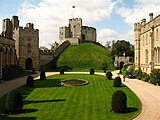Rape of Arundel
| Rape of Arundel | |
|---|---|
 |
|
| Area | |
| • 1831 | 132,800 acres (537 km2) |
| Population | |
| • 1801 | 22,478 |
| • 1811 | 24,276 |
| • 1831 | 31,064 |
| Density | |
| • 1831 | 0.23 inhabitants per acre (57/km2) |
| History | |
| • Created | 6th to 11th century |
| • Succeeded by | Sussex (western division) |
| Status | Rape (county subdivision) |
| • HQ | Arundel |
| Subdivisions | |
| • Type | Hundreds |
| • Units | Avisford (named Binsted in 1086 but had its later name by 1166),Bury, Poling, Rotherbridge, West Easwrith |
The Rape of Arundel is one of the rapes, the traditional sub-divisions unique to the historic county of Sussex in England.
The population of the rape of Arundel was 22,478 in 1801, falling to 24,276 in 1811.
The rape of Chichester lies to its west and the rape of Bramber lies to its east. To the north the rape is bounded by the county of Surrey and to the south by the English Channel. The rape of Arundel includes the towns of Arundel and Littlehampton. Its highest point is Glatting Beacon on the South Downs, which is 245 metres (804 ft) tall.
The rape is traditionally divided into the following hundreds:
...
Wikipedia
